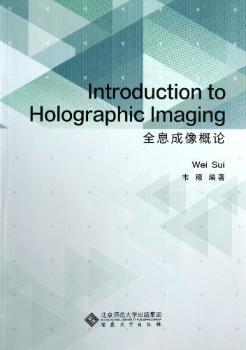内容简介
《全息成像概论》的章节编排具体如下:第1章先讨论人类视觉系统的性能,是人的3D感知。下面几章内容包括光全息术、计算机产生全息图和全息视频显示,本书将从光学与计算结合的新角度来论述。第3章给出经典光全息图的基本类型,但不追求广泛的综述。第4章围绕计算机产生全息图这个议题展开。第5章介绍当代技术——全息视频技术。
目录
Preface
Chapter 1 Holography.The Ultimate 3D Visualization Tool
1.1 Human 3D Perception
1.1.1 Anatomy
1.1.2 Stereopsis
1.1.3 Accommodation and Convergence
1.1.4 Motion Parallax
1.1.5 Pictorial Information
1.1.6 Some Photometric Visual Parameters
1.2 3D Visualization Systems
1.2.1 Stereoscopic Displays
1.2.2 Autostereoscopic Displays
1.2.3 Volumetric Displays
1.2.4 Holography
1.3 Historical Background
1.3.1 A Twostep Lensless Imaging Process
1.3.2 Whitelight Holography
1.3.3 Computergenerated Hologram
1.3.4 Holographic Video Display
1.3.5 Chinese Magic Mirrors
1.3.6 The Tentacled Holographic Entity
Chapter 2 Wave Optics
2.1 The Basic Nature of Lightwave
2.1.1 Maxwell's Equations and Wave Equation
2.1.2 Complex Representation and Helmholtz Wave Equation
2.1.3 Plane and Spherical Wave
2.1.4 Angular Spectrum Representation of Plane Waves
2.2 Scalar Diffraction Theory
2.2.1 HuygensFresnel Principle
2.2.2 Fresnel and Fraunhofer Approximations
2.2.3 Another Derivation of Fresnel Approximations
2.3 Polarization
2.3.1 Polarization
2.3.2 Polarizer, Rotator and Polarizing Beam Splitter
2.3.3 Electrooptical Characteristics of Liquid Crystals
Chapter 3 The Basic Types of Optical Hologram
3.1 Classical Optical Holography
3.1.1 Diffraction Grating
3.1.2 Inline Holography (Gabor Configuration)
3.1.3 Offaxis Holography (LeithUpatnieks Configuration)
3.1.4 Rainbow (Benton) Holograms
3.1.5 Reflection (Denisyuk) Holograms
3.2 Holographic Stereogram
3.2.1 What Is a Holographic Stereogram
3.2.2 Holographic Functional Screen
3.2.3 Holographic Screen for Image Projection
3.3 Practical Aspects of Optical Holography
3.3.1 Light Sources for Holography
3.3.2 Holographic Recording Media
3.3.4 &nbs




 VIP会员
VIP会员